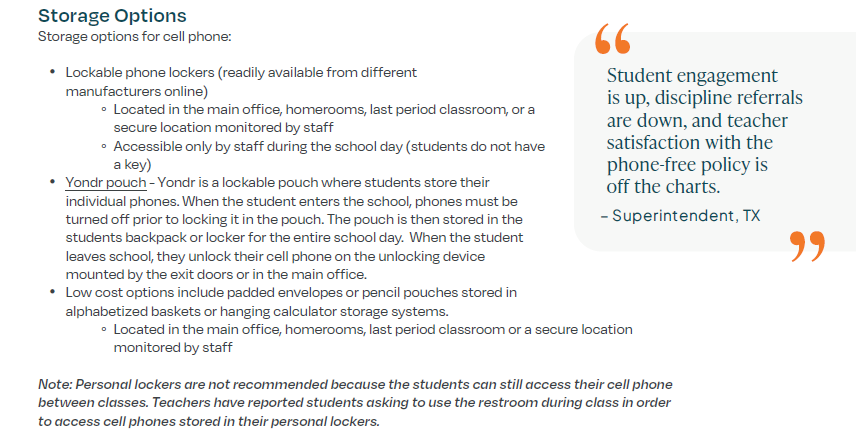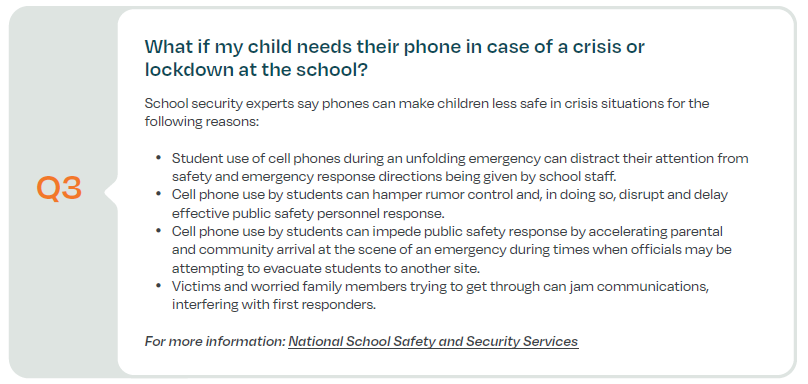Full disclosure - I am an ambassador with the Phone-Free Schools Movement, though I had nothing to do with creating the policy, which I’ll discuss below.
As I’ve mentioned before, I worry about the states whose legislatures have mandated that all public schools be phone-free by a specific date because if anyone has less of a clue about how a public school classroom works, it’s state legislators. My concern was that districts would push out pretty weaksauce policies, like the one my district decided upon and atta-boy’d themselves about.
But it doesn’t have to be that way.
Phone Free Schools Movement has just released its Phone-Free Schools Administrator Toolkit, which schools and districts can adopt outright or use as a foundation for their policy.
PFSM has asked that I not post the entire PDF here, and I won’t. Instead, they’d ask that any administrator (teachers can also get a copy) interested in what a phone-free school policy could look like go to their website, sign up, and have a PDF sent to them.
Before you click away, I want to review the Toolkit, explain why it’s so strong, and highlight a few minor quibbles.
Overall
Again, this is solid work, and my kudos and appreciation go to the team at PFSM that put it all together. It has three sections: Supporting Data, Implementation Materials, and Stakeholder Communications.
My most significant quibble is that this is aimed at school administrators. I get that, and I hope that works in the schools that adopt it. However, this assumes that school administration and schools within a district have full autonomy.
And they might.
As I mentioned, Principal Ewell Fuller implemented Yondr pouches in his school after he decided they were the way to go. No school board or district policy was needed, and that’s great. But I don’t think that will work in every school or district.
In these days of school resegregation choice, ill-informed and easily amplified outrage, and fear of an Angry Phone Call, I’d recommend that the Toolkit be presented to superintendents and administrators. Again, from personal experience, my administrator didn’t want to be seen as going rogue, which added friction to my push.
But that’s a minor thing. Let’s get into the meat.
Supporting Data
The Toolkit’s research support is broad and deep, with links to articles and research papers. It’s the phone-free schools advocate’s greatest hits collection, all in one place. With links!
Research Infographic
I like the collection of sources because it’s a pretty even split between the attention-distraction side of the phone coin (as Joe Clement and Matt Miles explained in Screen Schooled) and the social media side (see Jon Haidt’s The Anxious Generation).
Given the push by social media company-funded media to muddy the water around social media harms, which can be attractive to some looking to fight a bell-to-bell phone-free policy, I feel this split is essential.
Phones are a distraction and steal students’ attention, even when they’re not using them. Grades suffer tremendously with a phone available, along with critical thinking skills and so much more. Phones are bad news for students even before they get to social media.
In my last installment, I mentioned a quote from Maya Angelou1, “Do the best you can until you know better. Then, when you know better, do better.”
It’s impossible to come away from this Toolkit and say, “I didn’t know any better…”
Benefits of a Phone-Free Policy
Again, a “greatest hits.” I’m just going to list them out with any thoughts I have. The document has supporting statements on some, but they’re all pretty self-explanatory:
Less distractions - again, comments about Screen Schooled apply
Less cyberbullying
Fewer fights and social media-related drama—and fights in a school never end up on social media.
Increased engagement
Improved attendance
Boosted efficiency—I love this one. PFSM states, “Teachers report being ahead of schedule on lesson plans because they aren’t spending time policing phones.” I do not know of one teacher, living or dead, who wouldn’t see this as the reason for a school to go phone-free, but let’s continue.
More reading—media center coordinators cheer! And then shush themselves.
Improved teacher morale and retention
Less mid-class absenteeism—They’re talking about trips to the restroom or just wandering the halls because they’re not on their phones (this will be a problem with policies such as mine, where no one is watching students).
More vibrant lunchrooms
Less cheating—A buddy and I were swapping stories of students’ true confessions on how they use phones and devices to cheat. They’re so amazingly innovative. It would be nice to stop that.
Less reported stress among students
Implementation Materials
This is the guts of how to do it. It’s not bad at all, but it is pretty optimistic.
Rollout Timeline
Overall, the Toolkit suggests approximately a three-and-a-half-month timeline from the start of planning to launch completion.
In the image above, you’ll notice that surveys for teachers and students are mentioned. That’s key. In fact, throughout the timeline, communication is stressed. The goal is that no stakeholder feels left out or their voice isn’t being heard.
There are two more parts - a follow-up and a review, both crucial to the success of a phone-free policy.
Again, given my experience, if this isn’t coming from the top-down, a bottom-up, or even a robust grassroots push, it will get some pushback, either a little or a lot. That’s why this Toolkit needs to reach as many administrators and superintendents as possible—to help this push start from the top.
Also - once the decision is made, I’m not 100% sure what Yondr’s (it’s suggested as a possible solution) shipping schedule looks like these days. Again, minor quibble.
Implementation Guide
This portion is terrific—an outline of the policy, definitions of “cell phones” that include phones, AirPods, and smartwatches (with reasons why they should be included2), exceptions, communication plans, storage options, consequences, and enforcement.
It’s those last ones that I want to focus on.
First up—storage options. I mean, look at this:
This is bell to bell. It has to be bell to bell. For the critics saying that Yondr is too expensive, boom—there are low-cost options. And I love that the questions about personal lockers are already anticipated. But I mean, we all knew that already, right?
Next: Consequences
Limit to 3 or 4—agreed. My district’s original plan of 6 levels of offenses (I still think the policy committee could’ve gone to 20 but got tired after 6) did get trimmed, but this is better. Stark and to the point.
And then—Enforcement
This is just the start, but it’s essential and calls out the “honey-honey-baby-baby” teachers:
100% participation. Making the research available to the staff will be great, but staff accountability will also be needed. As the section says, consistency throughout the school results in less pushback by the students. The school’s entire policy can be rendered useless because everyone knows that Mrs. Smith lets you get your phone out if you’re done with your work.
If that’s the case, someone needs to talk with Mrs. Smith.
And this. I agree with 100%:
See the “honey-honey-baby-baby” teacher comments above. While this Toolkit isn’t about teacher policy, I would love it if the administration took this to mean that teachers can’t have phones out in meetings. And enforced it.
But…baby steps.
The section continues with comments about ensuring current procedures fit these guidelines.
Model Phone-Free Policy
And here it is. Too tired to make your policy? Just use this. Tweak a word or two, and you’re good to go.
The policy in the Toolkit is a culmination of the data and Implementation Guide.
This is where I have another issue, but it’s solvable or at least compromisable, I hope.
PFSM is adamant that all phones mean all phones. As I mentioned, I have students download apps on their phones for my classes, specifically physics. Phyphox is an app that allows users to access data from all their cell phone’s sensors (there are way more than you think) and has several unique tools.
For instance, the acoustic stopwatch starts and stops with sound. I use it for a lab where we measure the acceleration due to gravity (9.81 m/s^2, nerds). Trying to do this measurement with a stopwatch is ridiculously difficult and time-consuming, and it makes me feel stupid knowing that there’s an app that takes data collection down to about 10 minutes. 15, if the jokers are goofing around.
I don’t have a box of functioning stopwatches, and I certainly don’t have acoustic ones. The suite of Phyphox tools, along with a phone’s level tool (which I use in a friction lab), makes my class and data collection easier.
I’m still trying to figure out how to circumvent that, whether getting a class set of iPads (difficult, but not impossible) or some other solution. But I’m willing to make that compromise because
The benefits to the larger student body are more important than the ease with which my kids can collect data, especially if there’s a workaround.
Ultimately, it’s a quibble, something to be figured out, not a hill I want to die on.
Stakeholder Communications
If you’re looking at this and thinking, “sounds good, but what about…” PFSM has you covered.
First up…
Frequently Asked Questions
This will be crucial to explaining the policy to teachers first and then for teachers to handle parent concerns. Again, one teacher in a meeting with parents or at Open House (which are like church socials down here in the south) says, “Yeah, I know they want students to be phone-free, but I just don’t see why…” and the policy just took a mortal blow.
The FAQ section even touches the third rail. Hell, it licks the third rail:
Here’s that link if you’re curious. I’m going to write more about this next week.
The FAQ section goes through the top 12 questions (and has answers for them), including such classics as:
How do I contact my student during the school day?
Why can’t teachers be in charge of the class and collect the phones?
Will it be harder for students to make connections and friends if they are offline all day?
What if my child has an IEP/504 plan?
Don’t some students benefit from having social media?
And this one, which I’m just going to post in its entirety:
That is, your kids are kids, not high-functioning adults. Their phones and social media are designed to grab and hold onto their attention. I mean, if you’re reading this on your phone right now, you’ve probably gotten five notifications (and you checked two), and you’re getting itchy to see what’s being said on IG, right?
But our kids—yeah, the ones who come to us from home not knowing how to use their phones responsibly (shade intended) should be taught to use their phones responsibly. By teachers, some of whom can’t use their phones responsibly. And this should be done along with teaching the curriculum. That sounds like you’re saying, “Teachers should be phone police,” with more words.
As the great philosopher Jennifer Lawrence says,
Common Pushbacks
This is the gold of the Toolkit—how to deal with all the sticky stuff. It’s the answers to the “Yeah, but whattabout…?”
Here we go:
When a parent/student asks why the policy was changed
or implemented
When a parent/student states they need to have contact 24/7
When a parent states they need their phone in an
emergency situation
When a student/parent claims the phone is needed for
educational purposes
When a parent/student states they or their child feels more stress
and anxiety without their phone
When a student/parent claims they or their child needs AirPods
to listen to music for their anxiety
When a parent/student asks why can’t we just eliminate phones
during instructional time
Letters & Surveys
The rest of the Toolkit consists of letters to teachers, staff, parents, and students explaining what’s coming and why. After that, there is a 14-question survey: one for teachers and one for students (mentioned earlier as part of the communication).
These can be used easily as-is or modified as needed.
In Conclusion
Again, I must give massive credit to the Phone-Free Schools Movement for doing the heavy lifting. The Toolkit is a terrific resource that shows how it can be done. It’s not perfect (it’s called “Version 1.0,” so there may be changes), and critics and naysayers will have their problems3, but critics have problems with everything, and nay-sayers always say nay.
At best, this is a plug-and-play for a school or a district. At worst, it’s a springboard that will start the discussion and move things in the right direction.
And I know I pointed out at the start that I’m a PFSM Ambassador (you can be too! Join here!), so I’m not going to be objective.
Get a copy of the Toolkit if you’d like, but please point every administrator and superintendent you know to this page. Once you become an Ambassador, there’s a letter of introduction to the Toolkit that can serve as your opening, but I figure you can handle that before you join.
And finally, I’ll be 100% honest—even after all my other writing on this; I was faking being hopeful about schools going phone-free some (okay, a lot) of the time. That was mainly due to my own experience, which sucked.
Now, with the Toolkit, I don’t feel alone and see this as inevitable.
Now go out and stir up some shit.
Here in Winston-Salem, that was a cheap shot. Maya Angelou was a beloved resident and professor at Wake Forest University. She was known for large gatherings at her house (even Oprah visited) and for initiating various health partnerships and centers to provide better healthcare for the Black population. To suggest that the school board was going against Maya’s guidance was a punch below the belt, which I am not sorry to have made. Sometimes, you have to wake ‘em up.
Quibble—it should be mentioned that students with cell phones can use their phone as a hotspot (even if it’s collected and sitting up front) to gain access to the wide-open internet rather than use the school’s (monitored) wi-fi. I mean, you didn’t think they are able to access porn through the school’s wi-fi, did you?
Critics can just suck it. Can I quote Teddy Roosevelt here? “It is not the critic who counts; not the man who points out how the strong man stumbles, or where the doer of deeds could have done them better. The credit belongs to the man who is actually in the arena, whose face is marred by dust and sweat and blood; who strives valiantly; who errs, who comes short again and again, because there is no effort without error and shortcoming; but who does actually strive to do the deeds; who knows the great enthusiasms, the great devotions; who spends himself in a worthy cause; who at the best knows in the end the triumph of high achievement, and who at the worst, if he fails, at least fails while daring greatly, so that his place shall never be with those cold and timid souls who neither know victory nor defeat.”













